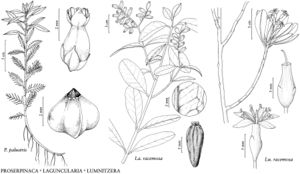Proserpinaca palustris
Sp. Pl. 1: 88. 1753.
Stems to 0.5 m. Leaves dimorphic to heteromorphic, pectinate or lobed to serrate; petiole (0–)1–7(–9) mm; submersed leaves pectinate, ovate, elliptic, obovate, or trullate in outline,(6–)20–35(–66) × (4–)10–25(–42) mm, segments (8–)14–20(–27), longest segment (2–)7–21(–31) mm; emersed leaves transitional, pinnatifid to shallowly lobed to minutely serrate, lanceolate, narrowly elliptic, oblanceolate, spatulate, or obovate in outline, (6–)15–65(–100) × (1–)2–17(–23) mm. Inflorescences: bracteoles lanceolate to deltate, margins irregular, serrate to lobed; primary bracteoles 0.6–16 × 0.3–0.9 mm, secondary bracteoles 0.6–0.9 × 0.3–0.5 mm. Flowers: sepals green to purple, cucullate, shallowly triangular, (0.6–)0.8–1.3(–1.5) × 0.5–1.2 mm; petals to 0.1 mm; filaments to 2.5 mm; anthers yellow, oblong, 0.6–1.2 × 0.2–0.7 mm; pistil 1.5–3.3 mm; style to 0.5 mm; stigma pink to purple, lanceolate, to 1.5 mm, fimbriate. Fruits 3-angled or -lobed in cross-section, (2.3–)2.5–4(–4.5) × (1.5–)2.5–4(–5.7) mm, margins convex to strongly concave, often winged, faces widely ovate, cordiform, or shallowly triangular, surface smooth to ± rugose, sometimes with weak and shallow lateral ridges; sepals strongly accrescent, ascending with appressed margins. 2n = 14.
Phenology: Flowering and fruiting May–Oct.
Habitat: Shores of lakes, ponds, rivers, streams, fens, and marshes.
Elevation: 0–700 m.
Distribution
N.B., N.S., Ont., Que., Ala., Ark., Conn., Del., D.C., Fla., Ga., Ill., Ind., Iowa, Ky., La., Maine, Md., Mass., Mich., Minn., Miss., N.H., N.J., N.Y., N.C., Ohio, Okla., Pa., R.I., S.C., Tenn., Tex., Vt., Va., W.Va., Wis., s Mexico, West Indies, Bermuda, Central America, South America.
Discussion
Historically, Proserpinaca palustris has been split into varieties, primarily based on differences in fruit width-to-height ratios and surface morphology. In the flora area, three varieties (vars. amblyogona, crebra, and palustris) have been recognized (N. C. Fassett 1953c; P. M. Catling 1998). Distributions of the varieties overlap considerably and variation in fruit is continuous; only one taxon is recognized here.
The leaves of Proserpinaca palustris can be highly variable, transitioning from submersed and pectinate with a narrow central axis to emersed with broader blades with serrate margins (B. McCallum 1902; G. P. Burns 1904; N. C. Fassett 1953c; W. B. L. Schmidt and W. F. Millington 1968). Intermediate leaf forms often occur, which vary in central axis width and extent of blade division (Fassett). A reversion in the transition from submersed forms to emersed forms can occur later in the growing season (G. J. Davis 1967) or when the latter leaf types become inundated (Schmidt and Millington). The divergence in leaf form is influenced by photoperiod and temperature (Davis; Schmidt and Millington; A. Wallenstein and L. S. Albert 1963), hydration upon submergence (McCallum; Schmidt and Millington; Wallenstein and Albert), light intensity (Millington), and endogenous growth factors (Wallenstein and Albert; M. E. Kane and L. S. Albert 1989).
Plants with leaf characteristics intermediate between Proserpinaca palustris and P. pectinata were described as P. intermedia Mackenzie. N. C. Fassett (1953c) and P. M. Catling (1998) also considered P. intermedia to be distinct, possibly of hybrid origin between P. palustris and P. pectinata. This intermediate form appears to arise sporadically; genetic evidence is needed to confirm the taxonomic status of this taxon. A wide range of leaf forms is also inducible in P. intermedia (M. E. Kane and L. S. Albert 1982) and these leaf forms completely overlap with those observed in P. palustris.
The suite of characters used by previous authors to distinguish Proserpinaca intermedia from P. palustris presents a continuum of variation. Therefore, in the absence of more definitive information, the former species is not recognized here as a distinct taxon.
Selected References
None.
